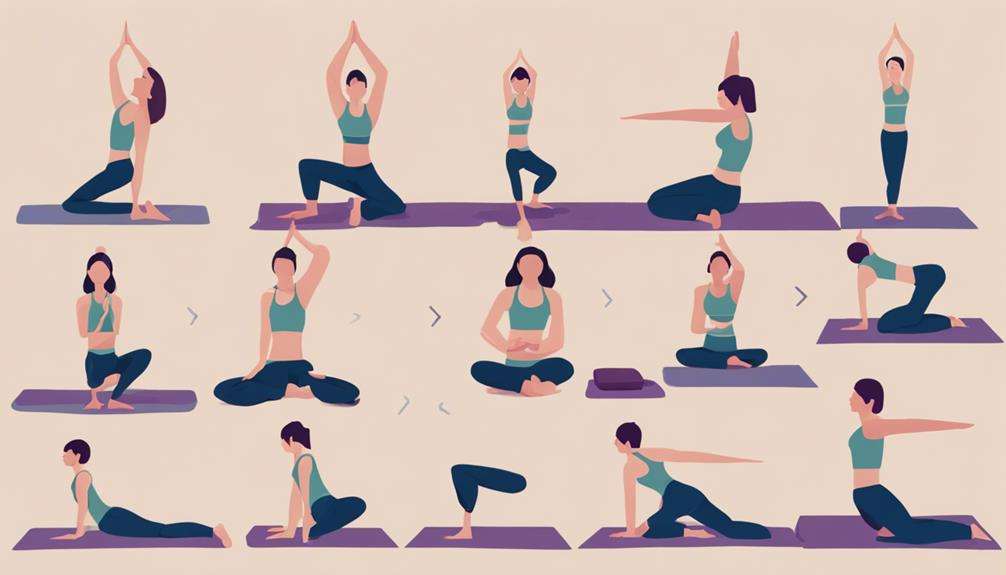Picture yourself steering through the turbulent waters of stress, feeling overwhelmed by the relentless waves crashing around you. What if there was a simple anchor, a tool to steady your ship and guide you through the storm?
Learning to master stress with mindful breathing can be that lifeline, offering you a way to find calm amidst the chaos.
Discover how harnessing the power of your breath can transform your experience of stress, providing you with a sense of control and peace in the midst of life's challenges.
Key Takeaways
- Reduce stress levels and promote calmness through mindful breathing techniques.
- Enhance emotional regulation and overall well-being with regular practice.
- Cultivate mindfulness and inner peace for a healthier, balanced life.
- Combat stress, anxiety, and negative thinking patterns for improved mental health.
Benefits of Mindful Breathing for Stress
Discover how incorporating mindful breathing into your daily routine can greatly reduce stress levels and promote a sense of calm and relaxation.
Mindful breathing isn't just about taking deep breaths; it involves focusing your attention on each inhale and exhale, engaging in a form of meditation that has profound effects on your well-being.
Studies have shown that practicing mindful breathing can lower cortisol levels, the stress hormone, leading to improved stress management. By dedicating as little as 10 minutes a day to mindful breathing, you can experience a significant decrease in perceived stress levels by up to 31%.
This simple yet powerful technique triggers the body's relaxation response, resulting in decreased heart rate and blood pressure. Additionally, mindful breathing enhances emotional regulation, helping reduce anxiety and fostering a sense of inner peace within you.
Incorporating mindful breathing into your daily routine can be a transformative tool for managing stress and promoting overall well-being.
Techniques for Mindful Breathing Practice
Ready to enhance your mindful breathing practice?
Let's start with the Deep Belly Breathing technique, focusing on slow, deep breaths to calm your mind and body.
This Counted Breath Technique will guide you through specific counts for inhalation and exhalation, promoting relaxation and mindfulness effortlessly.
Let's take a moment to explore these powerful techniques for a more centered and peaceful state of being.
Deep Belly Breathing
Engage your diaphragm for fuller breaths through deep belly breathing, a technique known for its stress-reducing and relaxation-promoting benefits.
Deep belly breathing involves utilizing the diaphragm to draw in breath deeply into your body, allowing for a more complete exchange of oxygen and carbon dioxide. This method can help slow your heart rate, lower stress levels, and maintain stable blood pressure.
By practicing deep belly breathing, you enhance your body awareness and cultivate a sense of relaxation within your mind. Regular practice of this technique can lead to increased breath capacity and improved stress management skills.
Take a moment to focus on your breath, feel it fill your body deeply, and let go of tension as you exhale.
Counted Breath Technique
As you move from deep belly breathing to the Counted Breath Technique, you can enhance your focus and mindfulness by incorporating a simple counting method into your meditation practice. Counting breaths creates a rhythm that promotes relaxation, aiding in stress reduction and a calmer state of mind.
This technique helps you maintain a steady pace of breathing, preventing distractions and anchoring your attention to the present moment. By counting each breath, you develop a heightened awareness of your breath, fostering inner peace and a deeper connection to your meditation practice.
The Counted Breath Technique is a straightforward yet powerful method to cultivate mindfulness, improve your ability to relax, and reduce stress effectively.
Steps to Master Mindful Breathing

To master mindful breathing, you need to understand the benefits it offers, practice techniques for deep breathing, and consistently engage in mindful breathing exercises.
By being aware of how mindful breathing can help reduce stress and improve overall well-being, you can start incorporating it into your daily routine.
Take the first step towards mastering mindful breathing by exploring its benefits and committing to regular practice sessions.
Benefits of Mindful Breathing
Discover the transformative power of mindful breathing as you reveal a path to reducing stress and enhancing emotional well-being.
Mindful breathing activates the parasympathetic nervous system, promoting inner peace and aiding in emotional regulation. It acts as a natural defense mechanism against stress, resetting the body's response.
Research indicates that practicing mindful breathing can lower blood pressure and heart rate, contributing to overall health improvement. By focusing on sensations and redirecting attention to your breath, you can effectively harness the benefits of mindful breathing for stress relief.
Embrace the calming effects of this practice and witness its ability to bring balance to your mind and body, paving the way for a more peaceful and centered existence.
Techniques for Deep Breathing
When mastering the technique of deep breathing for mindful breathing, it's essential to focus on engaging your diaphragm fully. Deep breathing, also known as diaphragmatic breathing, is vital for promoting healthier breaths and managing stress effectively.
By practicing intentional breathing, you can explore and gradually master this technique. Intentional breathing triggers the parasympathetic nervous system, initiating the relaxation response and breaking the stress feedback loop.
To enhance your focus during intentional breathing, try associating a word or phrase with each breath. These techniques not only aid in stress management but also help in maintaining a steady heart rate and blood pressure.
Practice these breath techniques to harness the power of deep breathing for a calmer mind and body.
Practice Mindful Breathing
Commence on your journey to mastering mindful breathing by incorporating simple yet powerful techniques into your daily routine.
- Practice Daily: Set aside a specific time each day to focus on mindful breathing, even if it's just for a few minutes.
- Try 4-7-8 Breathing: Inhale quietly through your nose for 4 counts, hold your breath for 7 counts, then exhale slowly through your mouth for 8 counts.
- Explore Box Breathing: Inhale deeply for 4 counts, hold your breath for 4 counts, exhale for 4 counts, and hold for 4 counts before repeating the cycle.
- Cultivate Awareness: Notice how mindful breathing impacts your mental health, reduces anxiety, and enhances your overall well-being with consistent daily practice.
Mindful Breathing's Impact on Stress Relief

Mindful breathing's impact on stress relief is profound, with its ability to activate the parasympathetic nervous system, reducing stress and anxiety levels substantially. By engaging in mindful breathing, you can reset your body's stress response, fostering a calmer and more balanced state of mind.
Studies have shown that this practice can lower cortisol levels, the stress hormone, aiding in long-term stress reduction. Additionally, improving heart rate variability through mindful breathing enhances your ability to cope with stressors, promoting greater resilience.
Taking just a few minutes each day to practice mindful breathing can lead to improved overall well-being by alleviating anxiety levels and promoting a sense of calm. Embrace this simple yet powerful technique to combat stress and cultivate a more peaceful state of being.
Start your journey towards stress relief today with the transformative practice of mindful breathing.
Mindful Breathing for Improved Wellness
To enhance your overall wellness and cultivate a healthier lifestyle, consider incorporating mindful breathing techniques into your daily routine. Mindful breathing is a powerful tool that can positively impact various aspects of your well-being. Here are some key benefits of mindful breathing for your improved wellness:
- Stress Reduction: Mindful breathing activates the parasympathetic nervous system, helping to reduce stress levels and promote relaxation.
- Pain Relief: Mindful breathing techniques have been found to be effective in alleviating pain and are being explored as a safer alternative to opioids.
- Emotional Well-being: Scientific research shows that practicing mindful breathing can help combat depression, anxiety, and emotional exhaustion by reducing negative thinking patterns and enhancing mood.
- Overall Wellness: By incorporating mindful breathing into your daily routine, you can experience an overall improvement in your well-being, leading to a healthier and more balanced life. Start your journey towards better wellness today by embracing the practice of mindful breathing.
Integrating Mindful Breathing Into Daily Life

Start by integrating mindful breathing techniques into your daily activities to experience a noticeable improvement in managing stress and enhancing your overall well-being. By incorporating simple breathing exercises into your routine, you can effectively practice stress management and mindfulness meditation. Dedicate a few minutes each day to focus on your breath, using it as an anchor to bring yourself back to the present moment and reduce stress levels.
Consistent daily practice of mindful breathing can lead to long-term benefits in stress reduction. As you cultivate this mindfulness practice, you'll gradually experience peace and tranquility in your life, even amidst challenges. Embrace relaxation techniques through mindful breathing to create a sense of well-being and balance.
Frequently Asked Questions
What Are the Steps for Mindful Breathing?
To master mindful breathing, take slow, deep breaths. Focus on the sensations. Redirect thoughts to your breath. Commit to daily practice for stress relief, calm mind, and inner peace. Increase session duration gradually. Embrace the mind-body connection.
What Is the 4 7 8 Breathing Method for Stress?
Feeling stressed? Try the 4-7-8 Breathing Method. Inhale for 4, hold for 7, exhale for 8. This technique promotes deep relaxation, reduces stress, and enhances focus. Practice regularly for a calm mind and emotional balance.
What Are the 5 Steps of Mindfulness?
To master mindful awareness, practice observing, describing, participating, non-judging, and non-attachment. Engage in breathing exercises for stress reduction and emotional regulation. Cultivate the mind-body connection, focus on the present moment, and embrace relaxation techniques for inner peace.
How Does Mindful Breathing Reduce Stress?
Reduce stress by mastering mindful breathing. Engage in calm, deep breaths to activate your body's relaxation response. By practicing mindfulness and regulating emotions, you can manage stress, lower anxiety, and foster inner peace effectively.
Conclusion
Now that you've learned the benefits of mindful breathing and different techniques to practice, it's time to put them to use.
Take a moment each day to focus on your breath, using intentional breathing to combat stress and improve your overall well-being.
Remember, the power of mindfulness lies within you, so embrace it and master stress with the simple act of breathing.
You'll be amazed at the positive impact it can have on your life.
So, take a deep breath and start your journey to a calmer, healthier you.






